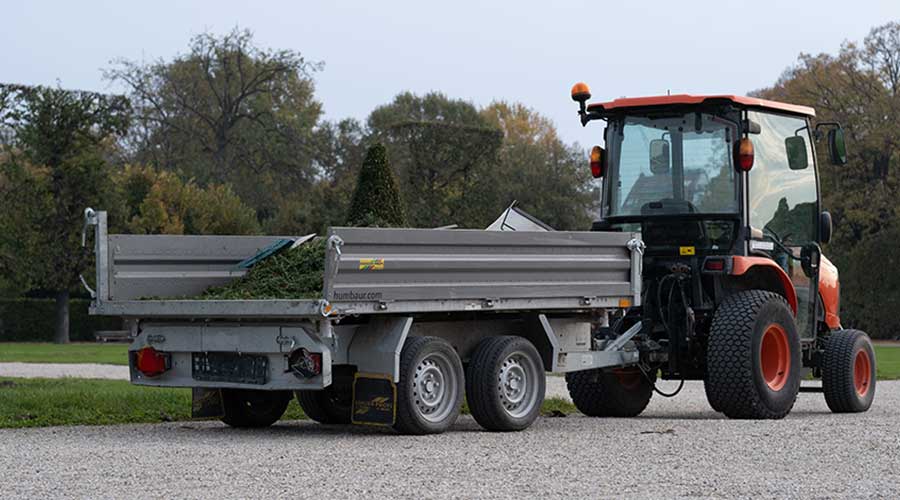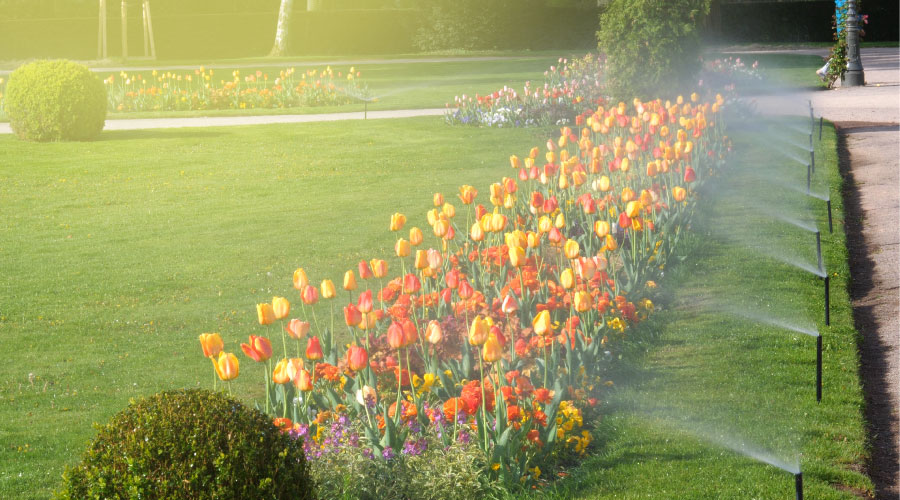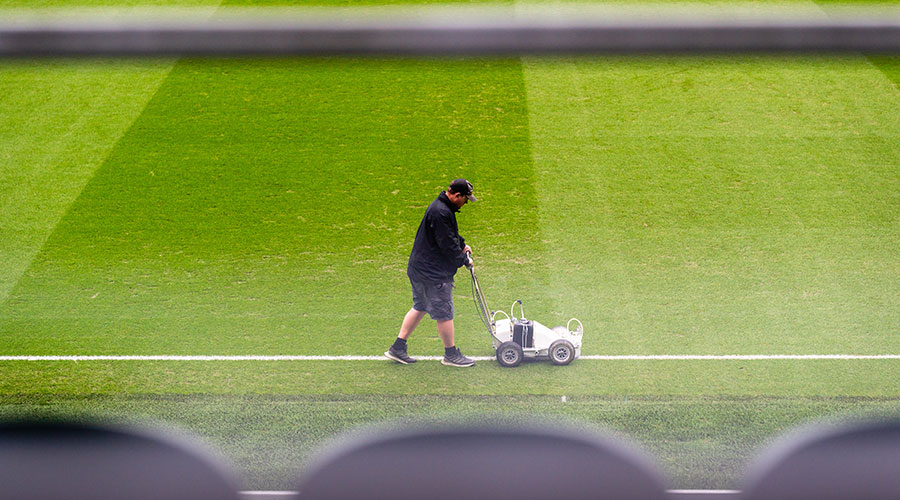The Power of Accessories
Mower and tractor attachments help managers enhance equipment usefulness and versatility
Winter months are fast approaching. Typically, the colder weather brings an opportunity to analyze grounds care operations and make plans to improve next year. When strategizing for the upcoming season, managers need to consider all of the attachments and accessories available for riding mowers and utility tractors.
With the surplus of attachments and accessories available today, managers can extend the usefulness and versatility of these machines well beyond cutting grass. By adding various attachments, managers can turn seasonal equipment into year-round tools, increasing productivity and making each piece of equipment more cost-effective.
Investigating Options
Mower attachments include mowing decks, snow blowers, blades, trailers, rotary brooms, debris and leaf blowers, vacuums, bed shapers, aerators, dethatchers, line trimmers, pavement edgers, stump cutters, sprayers, and spreaders. Useful attachments for tractors include mower decks, trailers, backhoes, loader buckets, augers, scrapers, rakes, aerators, snow blowers and blades, seeders, brooms, vacuums, top dressers, sprayers, and spreaders.
Additional valuable accessories include a variety of tires for various terrain, roll bars, light kits for working in the dark, hour meters to help determine when routine maintenance is due, hitch kits for pulling trailers, and canopies or cabs to protect the operator from the elements. Many manufacturers now also offer roll-bar attachments for use on older model mowers.
Todd Cochran, assistant county park superintendent with the Bergen County Department of Parks in Hackensack, N.J, says his operation uses 72 percent out-front mowers during the mowing season and attaches a leaf blower in fall and snow blower in the winter. On their utility tractors, they use flail mowers, rotary mowers, tillers, a three-point hitch backhoe attachment, auger, aerator, brooms and a tine harrow. Cochran manages 26 parks and four golf courses.
Ellen Newell, landscape manager at Utah State University, says all of her department’s mowers are dedicated only to mowing. The grounds care workers add a mulching kit in the fall to chop up leaves and leave them on the lawn. For other tasks, they use a utility tractor with leaf blower, aerator, top dresser, fertilizer spreader, broom and flail mower.
Matching Needs and Priorities
Managers should list all of the activities their crew is responsible for during the year and the hours each job consumes. A second list should prioritize the activities they would like to accomplish if they had the proper equipment and adequate man power. By comparing the activity lists to a list of available equipment and attachments, managers can increase worker productivity.
For example, a broom attachment might be nice but not practical if the grounds crew only spends one hour each week sweeping a parking lot or walkway. In this case, a backpack blower or push broom might be more cost-effective than a broom attachment. If there have been complaints about debris and it takes several hours to sweep the parking lots by hand or clean with a backpack blower, however, a broom attachment might be a cost-effective addition to a department’s equipment arsenal.
Managers should avoid getting too caught up in manufacturer claims for attachments. If managers think an attachment might allow crews to complete a task that their department is not already doing, they first should determine the importance of that task. More than likely, if the task was really important, the grounds care crew would be doing it already, and adding that new task to the department’s workload might not be necessary.
After preparing a list of attachments or accessories that might be really valuable to grounds care operations, managers should make a thorough evaluation of their current equipment.
Equipment dealers or manufacturers can inform managers of attachments that can be adapted to their existing mowers or tractors. Many attachments are specific to a particular make and model, however, sometimes they are just specific to the manufacturer. Many attachments such as aerators, sprayers, and spreaders are universal and can be used with most name-brand equipment. The manufacturer may endorse third-party attachments for use with their equipment.
“Most of our attachments are made by the manufacturer of our tractor, however, we have made modifications to some so that they will work with our current equipment,” Newell says.
Adequate power is essential. Vehicles need an adequate engine size and proper hydraulics to run the attachment. Some attachments are equipped with their own power and do not rely on the tractor or mower.
“We tried a snow-plow attachment on one of our mowers, but it just didn’t have the power to work effectively,” Newell says. “We now use our utility tractor that is designed for heavy-duty work on hilly ground for tasks other than mowing.”
Upon evaluation of current equipment inventory, managers might discover that purchasing a new piece of equipment is most cost effective. When managers need to purchase a new mower or utility tractor, it is the perfect opportunity for them to research all of the options that are available with a new vehicle.
“If mowing is the primary activity to be accomplished with this machine, make sure the equipment meets your mowing needs first then decide if it can accomplish other tasks,” Cochran says. “Attachments should be the secondary consideration.” But if mowing will not be the primary function, then versatility should take precedence.
If an older mower is ready for retirement, is still in adequate working condition, but is not reliable for day-to-day mowing, managers might consider outfitting it with a time-saving broom or vacuum. Adding any type of attachment that is of value and does not put a lot of strain on the vehicle might be a way to extend the useful life of the equipment.
“Have your staff test the machine and all of its desired attachments before you buy,” Cochran says. Mechanics should inspect the equipment for ease of maintenance, ease of attachment, and access to lubrication points. Operators should practice using the attachments, as well as taking them off and reattaching them, especially if this will be done frequently or in the field. If it is too complicated or requires special tools, managers might reconsider its real usefulness.
“It takes two men about one hour to attach the leaf blower to our mower,” Cochran says. “That’s why we wait until the end of the mowing season to add the blower. During mowing season, the mowers are used for mowing only. The utility tractor with the attachments on a three-point hitch take minutes to add or remove, making them much more useful throughout the season.”
Avoiding Conflicts
Adding attachments to mowers or tractors might seem like a great way to increase productivity, but managers need to consider the current schedule of the equipment. When planning to add an aerator to a tractor that the grounds care crew normally uses to pull a mower, managers need to make sure that mowing is not a critical operation that must be done at the same time as aeration.
The best uses for attachments are those that extend the use of the equipment into seasons or times when it is not normally productive. For this reason, snow blowers and leaf vacuums are the two of the most popular attachments for mowers.
Often, several workers share utility tractors, mowers and attachments. Departments should have guidelines for scheduling use and maintenance of the equipment.
When equipment is shared, it is too easy for workers to let others assume responsibility for routine maintenance and fixing breakdowns. To avoid scheduling conflicts, one person should be responsible for the equipment, and anyone wanting to use it must check it out.
Fine-tuning the Decision
The cost of attachments usually will be lower than that of a dedicated piece of equipment, however, managers still need to do their homework. The attachment should save time and be convenient to use, or crews might be better off with a piece of lower-priced, walk-behind machinery, hand-held tools or simply renting equipment as needed.
Shop storage might be a concern, although attachments usually require less storage space than a separate, dedicated piece of equipment. Managers should consider transportation needs. Will the current trailer carry the tractor or mower plus the needed attachments? The equipment’s weight, as well as physical space on the trailer, might be considerations.
Operators need to be properly trained to install and remove the implements. If attachments are installed only once per year and left on for the entire season like a snow blower, it might be more productive to have one person trained in the set-up of equipment. Safety inspections should be completed immediately before the equipment is used.
Whether it is sporting a mower deck or snow blower, the machine and attachment should be inspected before each use to ensure it is in proper working order. These safety inspections are extremely critical when attachments are changed frequently because connections and parts can become worn or loose.
Getting more done with fewer people and less money is a constant battle for most, if not all, grounds care managers. Using attachments and accessories for mowers and tractors are worth serious consideration to help meet this critical challenge.
Related Topics:











